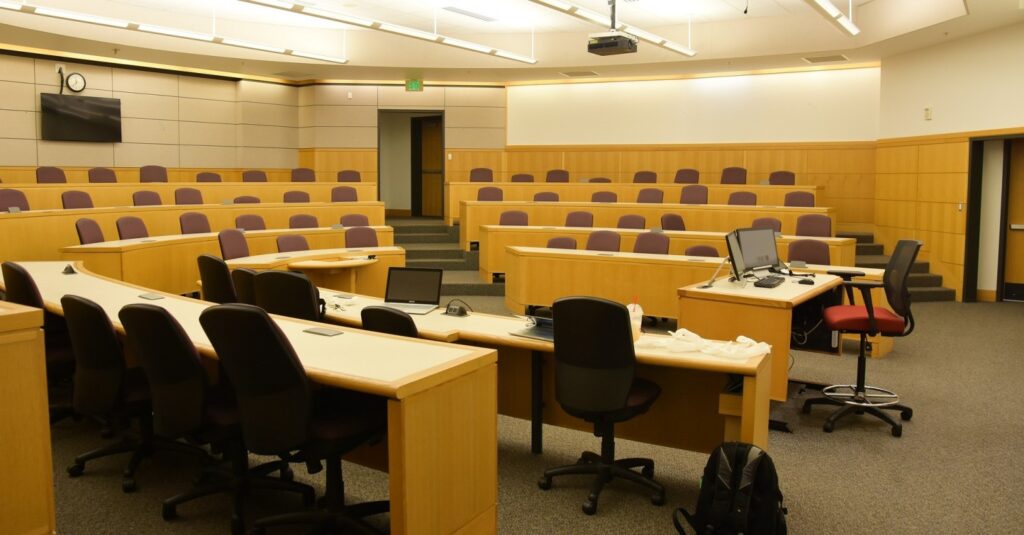
Recent Trends in Business Master's Applications and Admissions
The pandemic shook up the predictable world of business master's [...]

Every year, the Graduate Management Admissions Council (GMAC) surveys business graduate applicants to learn their attitudes and anticipate graduate business school admissions trends. The results offer a rich information trove for business school admissions departments, their marketing teams, and—perhaps less obviously—prospective MBA students. If you’re thinking about pursuing your MBA, here are the latest admissions trends you’ll want to know about.
The annual Application Trends Survey (ATS) offers insights to business school admissions offices worldwide; they use the data to assist with recruitment strategies based on candidate trends.
The GMAC is active in all matters pertaining to graduate management admissions. In addition to the survey, the GMAC administers the Graduate Management Admission Test™ (GMAT™) exam used by more than 7,000 graduate programs worldwide. Most are Master of Business Administration (MBA) programs; according to GMAC data, these test scores figure in 9 out of every 10 new MBA enrollments worldwide.
This annual survey report contains valuable information on the following data:
We’ll summarize that data in this article.
The Graduate Management Education (GME) report delivers a thorough compilation of global data, including application trends and candidate demographics from business school programs worldwide. The data collected includes responses from 450 participating MBA programs and 494 business master’s programs. This edition reflects the 2020-2021 admission cycle.
Although the number of women in leadership positions may lag behind the number of males, applications for MBA programs trend higher among women. The data suggests that today’s MBAs could serve as launchpads for more women to fill those C-suite positions down the road.
In 2021, 60 percent of full-time two-year MBA programs reported an increase in female applicants. An even more impressive 80 percent of online MBA programs saw an increase in the number of female applicants in 2020 (followed by another increase at nearly half of online programs in 2021).
Women in leadership roles were seemingly impacted more by the pandemic, working reduced hours or resigning due to personal factors such as childcare or caregiving for parents. However, women still lead in MBA applications, showing they have the ambition to move up the corporate ladder and seek opportunities to bolster their qualifications for those roles.
2020 was a year of uncertainty. It was also a year of self-reflection, with terms such as the Great Resignation and the Great Reshuffle becoming new buzzwords. This trend was reflected in the surge of applications to business programs globally from MBA candidates with less than three years of work experience. As some business schools relaxed their admission requirements, their doors opened to candidates who previously hadn’t been in the workforce long enough to pursue an MBA at a highly competitive program.
In 2020, the application volume for MBA programs spiked, with 41 percent coming from candidates with less than three years of experience, up from 30 percent in the previous year. The United Kingdom saw the highest surge, from six percent in 2019 to 41 percent in 2020 among applicants with less than three years of work experience. That number dropped back to the more-typical 4 percent in 2021 as the pandemic began to recede.
Early career professionals may not always land their dream job right after college, or they may consider a career switch early on. That’s where an MBA from a top business school can help. It can provide foundational business skills across functions (not just your in your area of expertise), expand your professional network, and help land a higher salary when re-entering the workforce.
An international candidate is any applicant whose citizenship is different from the country of the program location. A domestic candidate is any applicant whose citizenship is the same country as the program. U.S. candidates who study abroad qualify as international students.
Even with travel restrictions worldwide, tightened immigration policies, and lack of access to student visas, international applicants surprisingly surged in 2020. That’s because more programs offered online learning options and relaxed some of their admission requirements, conducting interviews online, waiving admission fees, and allowing student entry deferral. The trend abated somewhat in 2021, returning to levels comparable to those seen pre-pandemic.
Applications to MBA programs spiked globally in 2020 as the economic uncertainty caused by the pandemic sent many into a frenzy. In addition, the shift in the labor market led some to pursue business education at top MBA programs to enhance their professional development in preparation for a new career—or even entrepreneurship and freelancing opportunities.
Leading business schools in both the U.S. and Europe that experienced a surge in applications included:
2020 showed tremendous growth in applications, and 2021 indicated no slowing down. Applications continued to trend above pre-pandemic numbers. Two in five (41 percent) graduate business programs received more applications in 2021, sustaining the momentum from the previous year. The application trend remains strong.
Admission rates spiked in 2020. The momentum around acceptance rates and yield rates carried into 2021, when deferral rates began to decline:
Although acceptance rates were higher on average, Harvard Business School (HBS), with one of the most competitive MBA application processes known worldwide, still maintained a relatively low acceptance rate of approximately 9 percent during the 2020-2021 admission season.
As you consider pursuing an MBA degree, note that no two business school applications are the same. Some b-schools may waive the GMAT and accept the Graduate Record Examination (GRE) General Test—most applications state their preference. Some require significant work experience; others accept students fresh out of undergraduate programs.
Online and other nontraditional MBA program formats grow more widely available each year. Today, prospective students choose among four program options: on-campus (these include both part-time and full-time MBA programs), online, hybrid, and flexible. All four formats saw increased applications in 2021, the first year for which the survey disaggregated this data by program characteristics. Online saw the most dramatic increases, with applications up at 46 percent of participating programs (and 49 percent saw an increase in applications from women). On-campus followed (43 percent), trailed by hybrid (41 percent) and flexible (37 percent).
| University and Program Name | Learn More |
|
Pepperdine University:
Online Master of Business Administration
|
|
|
Stevens Institute of Technology:
Online Master of Business Administration
|
|
|
Merrimack College:
Master of Science in Leadership
|
|
|
Merrimack College:
Master of Science in Management
|
|
|
The University of Tennessee:
Online Master of Business Administration
|
Whether you prefer the MBA credentials following your name or pursue a general business master’s program, the choice is yours—and either option is a good one. An MBA is typically considered the preferred choice for business generalists and professionals seeking roles in upper management and strategy positions. A business master’s—such as a Master of Science in Business Intelligence—delivers deeper expertise in a single discipline (at the expense of broader knowledge across business functions).
According to the 2021 Application Trends Survey, two in five MBA and business master’s programs reported increased application volume last year, showing the popularity of both programs. In addition, while the acceptance rates for each type of program only differed by one percent, the average deferral rates for MBA programs (four percent) were double that of business master’s programs (two percent).
Before the pandemic, the number of applications for graduate programs hit a three-year low, dropping by 3.1 percent in 2019. A strong job market for domestic candidates and immigration policies that did not favor international candidates both factored into this trend. However, in the wake of the pandemic, graduate programs offered more flexible admission policies in a shaky economy, resulting in a surge in applications in 2020 that carried into 2021. Due to the impact of COVID:
Some programs even waived application fees and increased the size of the waitlist to accommodate the surge of both domestic and international applicants. The question now becomes whether this trend will continue during the 2022 admission cycle.
The numbers don’t lie. Universities and colleges worldwide have had to change admission policies during unprecedented times—and we aren’t in the clear just yet. More flexible opportunities have opened the door for more individuals to pursue an MBA. Of those individuals, women, minorities, early career professionals, and international candidates have increased their application volume by record-high amounts.
Organizations may consider a “return to normal” as the pandemic subsides, but it may be hard for graduate business programs to fully return to pre-pandemic policies now that students have enjoyed two years of increased accessibility.
Questions or feedback? Email editor@noodle.com

The pandemic shook up the predictable world of business master's [...]

Data scientists use data analytics, artificial intelligence. and machine learning [...]

A finely tuned resume plays a critical role in making [...]

Many engineering management and leadership positions require a master's degree. [...]

Computer science encompasses a broad range of academic disciplines and [...]
Categorized as: Business Administration, Management & Leadership, Business & Management